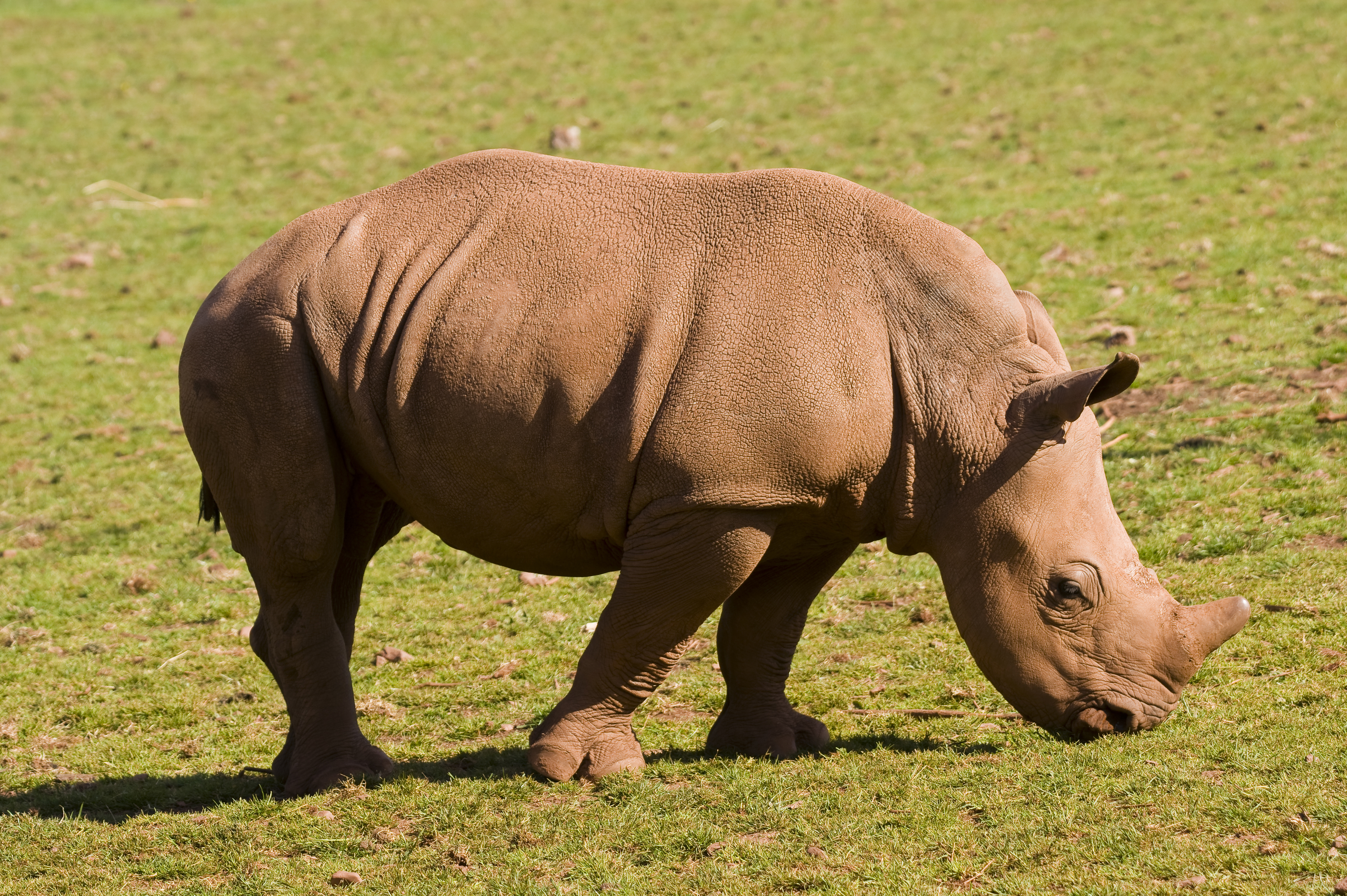Rhinoceros is a mammal known for its large size and horned nose. A mammal is an animal that feeds its young on mother’s milk. The rhinoceros ranks as one of the largest land animals, with many adults weighing several tons. The rhinoceros is sometimes called the “rhino” for short. Human activities, such as hunting, have caused severe declines in rhinoceros populations. Three species (kinds) of rhinoceroses are critically endangered—that is, they are at very high risk of becoming extinct.
The rhinoceros has an immense, solid body and short, stocky legs. Its thick skin appears to lie in folds but is actually just creased at the joints. Most species have little hair. Depending on the species, the rhinoceros has one or two slightly curving horns sticking up from the top of its long nose. Rhinoceros horn continues to grow throughout the life of the animal. It consists of a fiberlike material called keratin, the same material that makes up human hair and fingernails, among other things. The horn is not fixed to the rhinoceros’s skull and can be torn out during fighting. The name rhinoceros comes from two Greek words and means nose-horned.
The rhinoceros is in a group of mammals noted for having an odd number of developed toes on each foot. Each rhinoceros foot has three developed toes. The center toe holds the majority of the animal’s weight. The rhinoceros and hippopotamus may appear similar in body shape, but they are not closely related. The hippopotamus is a relative of pigs, camels, and cows. The rhinoceros is more closely related to the horse.
Some rhinoceroses are grazers. They eat mostly grass. Others are browsers. They eat leaves, twigs, and shrubs. Wild rhinoceroses live in Africa, in southeastern Asia, and on a few large islands near the Asiatic coast. In prehistoric times, they also roamed over Europe, North America, and northern Asia. Paraceratherium, a prehistoric relative of the modern rhinoceros, was the largest land mammal to ever live. This animal reached over 16 feet (5 meters) in height. On average, a rhinoceros lives from about 18 to 34 years. Some, however, have been known to live about 50 years. 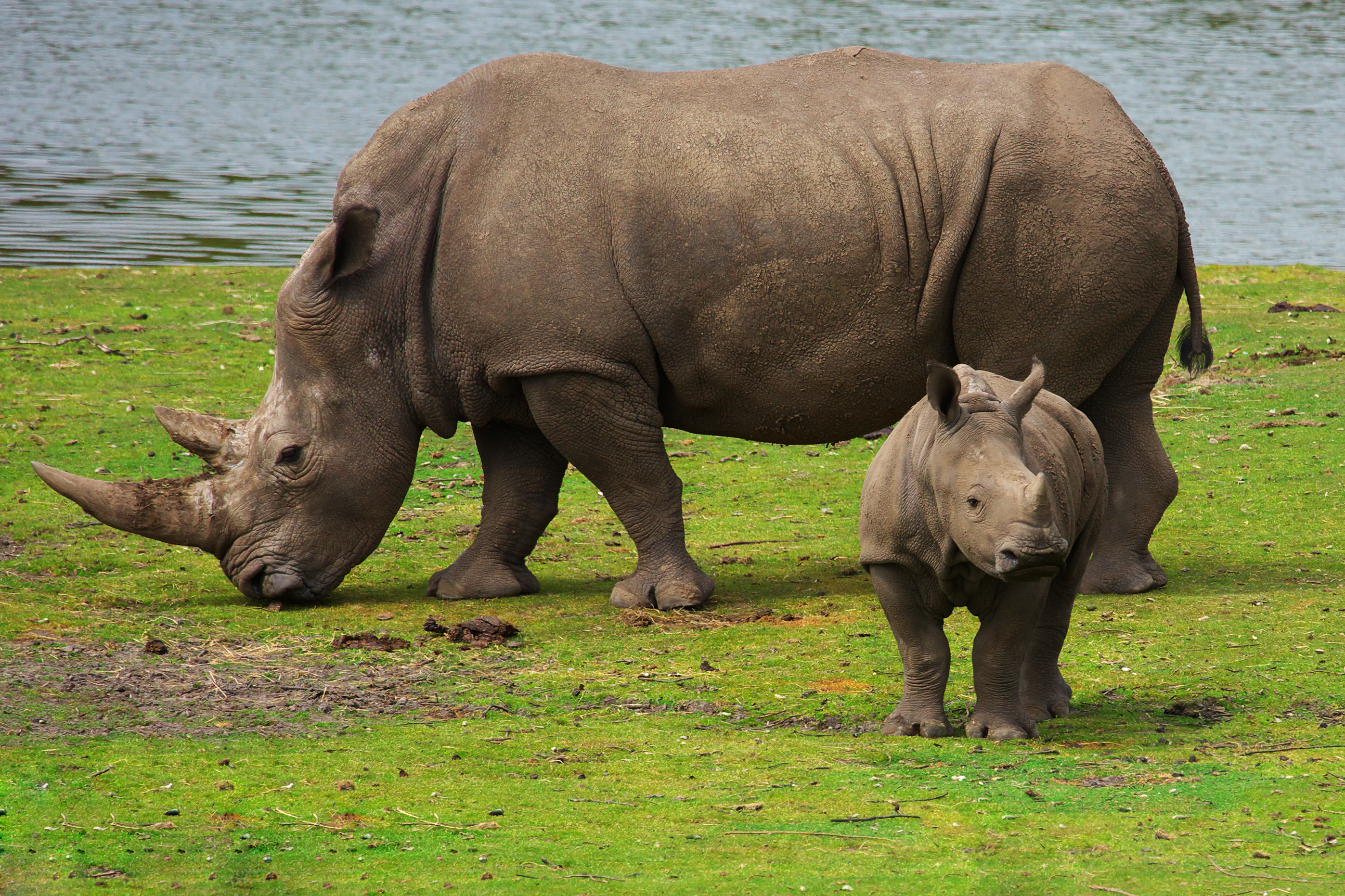
Kinds of rhinoceroses
There are five living species of rhinoceroses. Three of them live in Asia and two in Africa.
Indian rhinoceroses
include two species that have a single horn: the greater one-horned rhinoceros and the Javan rhinoceros. A third species, the Sumatran rhinoceros, has two horns.
The greater one-horned rhinoceros,
also known as the Indian rhinoceros, is the largest of the three Asian species. It stands about 5 feet 8 inches (1.7 meters) high at the shoulder and weighs 2 tons (1.8 metric tons) or more. It has a single horn that is thick at the base and about 1 to 2 feet (30 to 60 centimeters) in length. In rare cases, the animal may stand up to 6 1/2 feet (2 meters) high at the shoulder. The skin of the Indian rhinoceros is pebbled (covered in round knobs) and hangs in folds that make it look as though the animal were wearing plates of armor. The skin, however, though thick, provides little protection against bullets and knives used in poaching (illegal hunting). The animal lives in marshy jungles among reeds and tall grass, on which it feeds morning and evening. When not grazing on land, the rhinoceros may immerse itself in water and feed on aquatic plants. Ancient peoples of Asia knew this rhinoceros well, and it was even brought to ancient Rome to be used in the circus games.
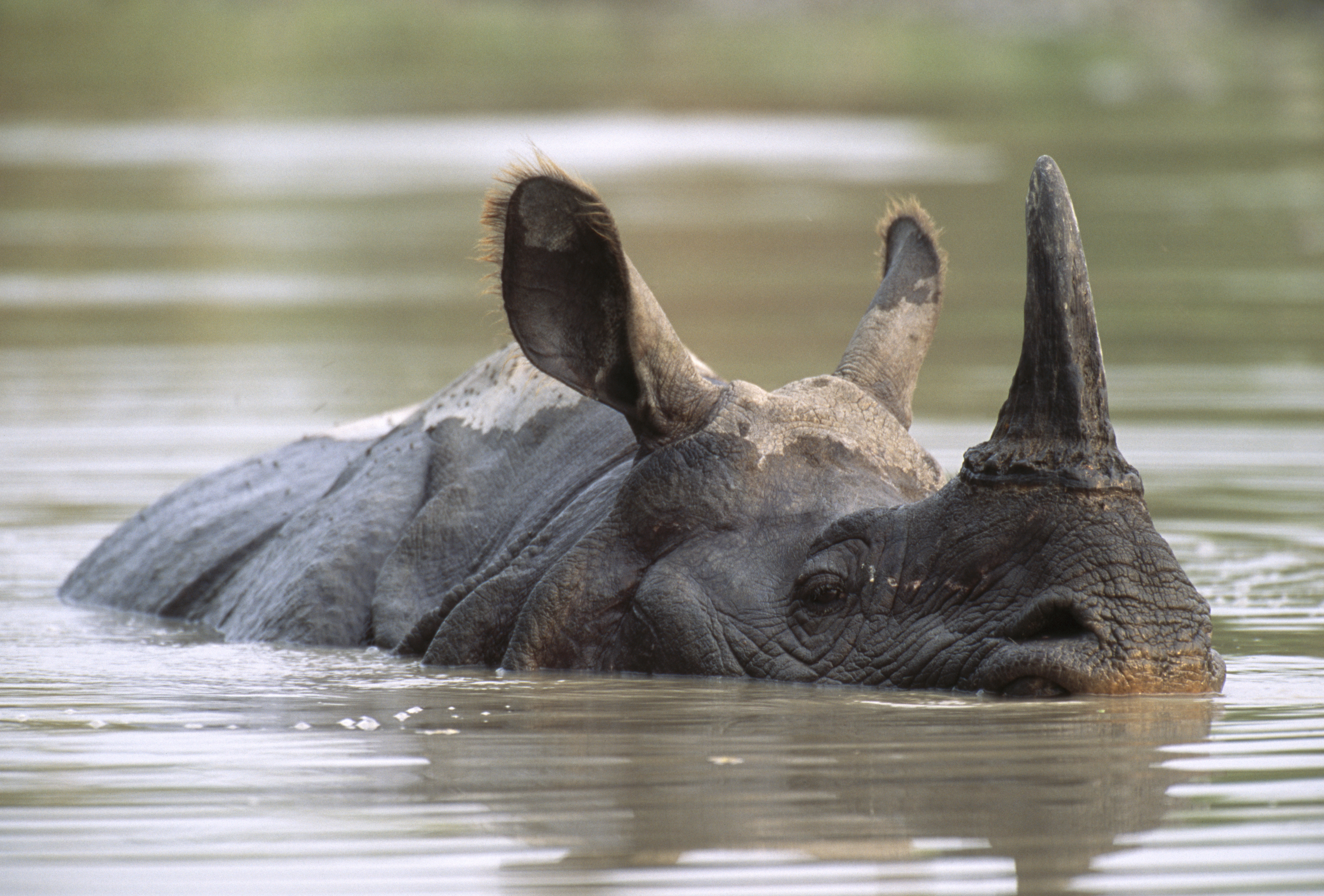
The Javan rhinoceros
is similar but smaller. It is now only found on Java, though it once ranged from Bangladesh into Myanmar and southward to Java, Borneo, and Sumatra. It lives in forested hills.
The Sumatran rhinoceros
is smaller than any other rhinoceros and has two horns. It stands about 4 1/2 feet (1.4 meters) tall and weighs about 1 ton (0.9 metric ton). It is hairy, especially on the tail and ears. The young have more body hair than the adults. This species lives in Sumatra, in Borneo, and on the Malay Peninsula. Like the Javan rhinoceros, it lives in forested hills.
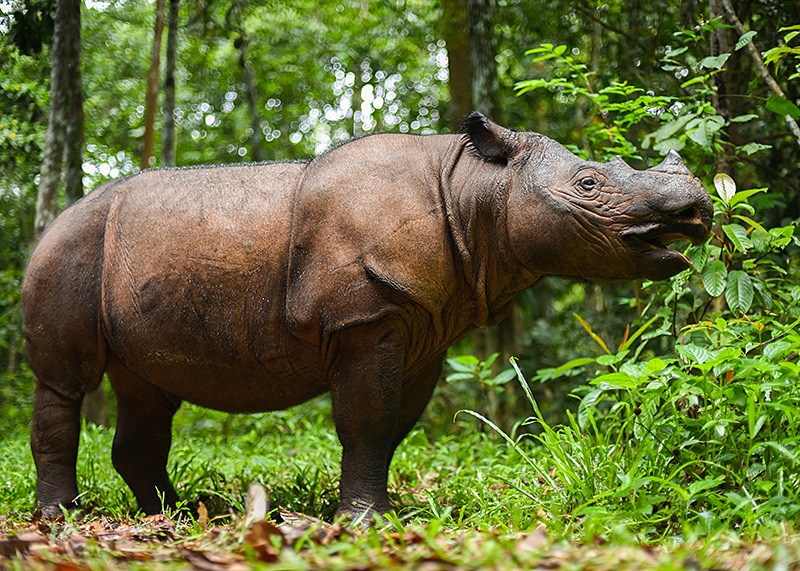
African rhinoceroses.
The two African species are two-horned. They are known as the black rhinoceros and the white rhinoceros, though they are almost the same bluish-gray color. Their lips differ in shape because they are specialized for eating different types of foods. Thus, the black rhinoceros is also called the hook-lipped rhinoceros, and the white rhinoceros is known as the square-lipped rhinoceros. In both species, the horns of the female are longer but more slender than those of the male.

The black rhinoceros
has a front horn that is sometimes as long as 4 1/2 feet (136 centimeters). It uses this horn to defend itself and to dig. The rear horn may be the same length or shorter. The front horn is so strong that the animal can easily uproot bushes and small trees with it. The black rhinoceros feeds on leaves and twigs. Although it appears clumsy, the black rhinoceros can run quickly, up to 35 miles (56 kilometers) per hour.
The white rhinoceros
is the largest of all rhinoceroses. It stands about 5 to 6 feet (1.5 to 1.8 meters) tall. In some cases, it may be over 6 feet (1.8 meters) tall and 15 feet (4.6 meters) long. It weighs up to 4 tons (3.6 metric tons).
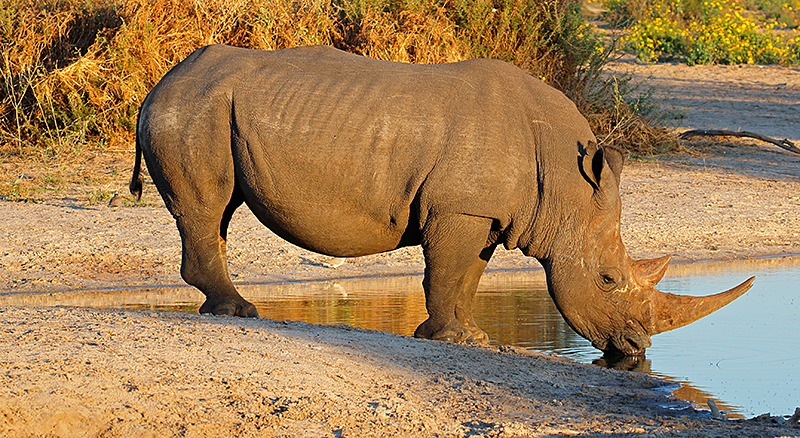
Threats to rhinoceroses
Various threats have caused rhinoceros populations to decline. As human populations have grown and spread, people have destroyed the habitat of the rhinoceros, particularly the Javan and Sumatran species. All rhinoceroses are threatened by poaching. Poachers kill rhinoceroses and sell their horns and skin. In some Asian traditions, the powdered horn of the rhinoceros is believed to have healing qualities and may be used to treat headaches, fevers, and many diseases, including cancer. Rhinoceros skin, blood, and urine may also be used in traditional medicine.
Only a few thousand rhinoceroses remain in Asia. The Javan rhinoceros is now nearly extinct, with the few remaining individuals living in one national park in Java. The Sumatran rhinoceros is also nearing extinction. The black rhinoceros remains threatened with extinction. Though protective measures have helped its numbers recover from their lowest point, the species remains critically endangered. Several thousand black rhinoceroses remain in the wild. In southern Africa, increased government protection and other conservation measures led the population of white rhinoceroses to rebound from fewer than 50 animals in the early 1900’s to thousands of animals in the early 2000’s. However, these animals are once again being threatened by poachers.
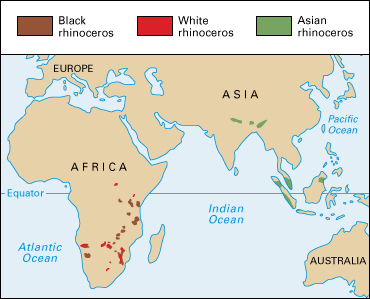
Many countries have laws intended to protect the rhinoceros from poaching, and international treaties have banned the trade in rhinoceros parts. In some countries, such as India, Indonesia, Kenya, and South Africa, special teams of antipoaching rangers keep constant watch over the animals and their habitat. In such countries as Namibia, South Africa, and Zimbabwe, wildlife officials have further attempted to reduce poaching by surgically removing the horns of some rhinoceroses. This process is called dehorning. Many scientists, however, believe this approach puts the animals in even greater danger. Hornless rhinoceroses are less able to protect their young against such predators as lions and hyenas. Also, poachers may kill hornless rhinoceroses for the horn root or in defiance of those who would protect rhinoceroses.
Loading the player...Rhinoceros running through grassland
In addition to antipoaching efforts, attempts have been made to increase the populations of certain species of rhinoceroses, both within and outside of their home countries. For example, black and white rhinoceroses have been sent to Australia and the United States to form breeding populations for future return to their natural habitats. Despite these efforts, wild rhinoceroses may soon cease to exist.
